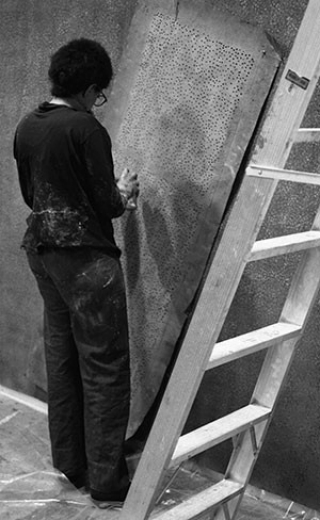Born 1943, Philadelphia, Pennsylvania
Howardena Pindell held positions at MoMA, first as an exhibition assistant and eventually as an associate curator of prints and illustrated books, after earning an MFA from Yale University in 1967. Throughout the 1970s Pindell also exhibited her abstract, mixed-media works while becoming active in the civil rights and women’s rights movements. When she left the museum in 1979, she joined the faculty of the State University of New York, Stony Brook, where she achieved tenure in 1981. Pindell confronted her experience of racism in the art world and within feminism in her landmark video, Free, White and 21 (1980), and has published many important critical essays, including a compendium of statistics about the exclusion of women and people of color by major museums.
As both an artist and a curator, Pindell led a kind of “double life.” Her body of work can also seem insurmountably divided—between her early abstract works and the representations of personal memories and direct commentaries on social issues that she made after 1979. Pindell first became known for her richly material confections of paper dots. Made with a quotidian hole punch and usually suspended in paint, the paper discs resemble the atomized marks of post-impressionist painting, gathered into subtle, atmospheric fields of color and texture. For other works, hand-numbered, unpainted dots are aligned into vast grids that dissolve into a numerical sublime.
While abstract, Pindell’s works nevertheless eloquently register her experiences and political positions on such issues as homelessness and war. In Untitled of 1977 the artist evokes the monotony of office work, channeling the repetitive action of hole punching into an overwhelming, irrational formal accumulation. This profusion is ordered by a grid made of squares of canvas, which are stitched together to form a support that remains unstretched. The secretarial detritus constituting the matter of the painting is in this way structured according to another form of gendered labor: sewing. The sparkling, encrusted surface, rendered in a palette of creamy pastels and including materials such as sequins, glitter, and perfume, also calls to mind traditionally feminine forms of adornment. In an essay from 1984 Pindell linked her approach to decoration to her ongoing interest in various African aesthetic practices.
Jenevive Nykolak
Howardena Pindell: Odyssey. New York: The Studio Museum in Harlem, 1986.
Howardena Pindell: Paintings, 1974–1980. New York: Garth Greenan Gallery, 2014.
